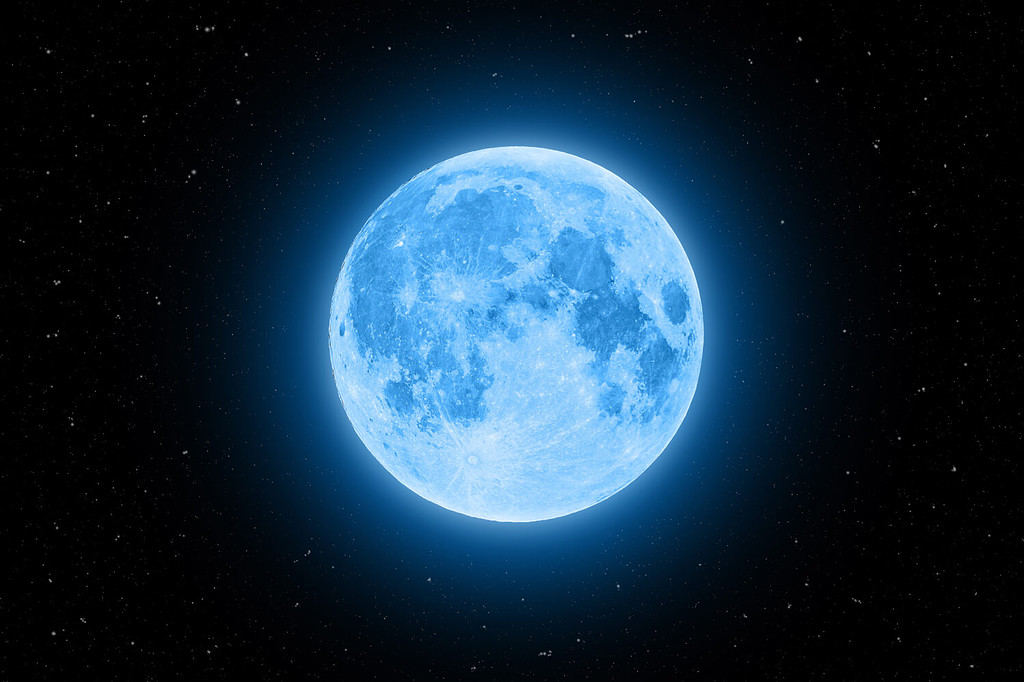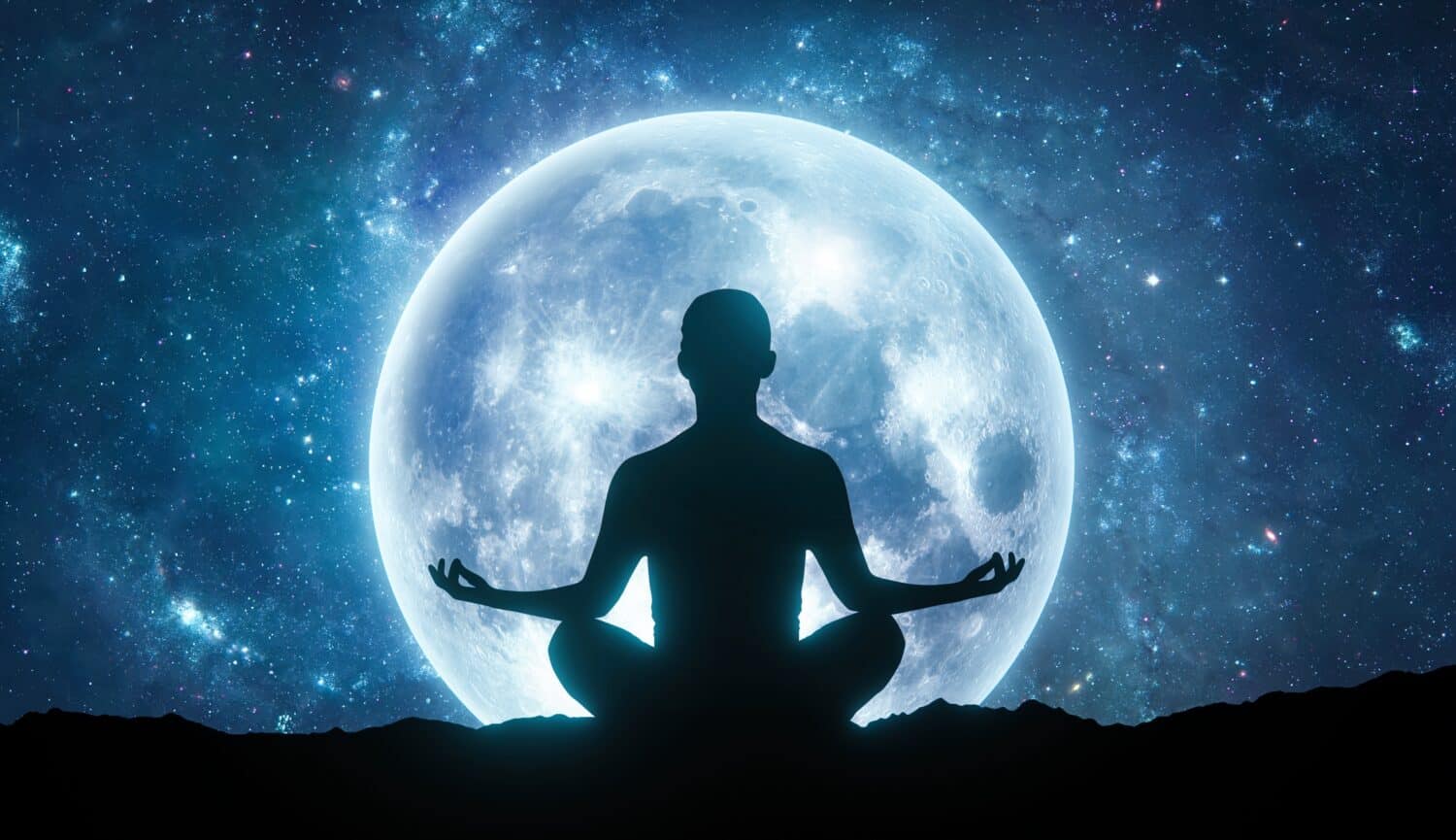The Blue Moon has long captured the imagination of many cultures, spiritual practitioners, gardeners, and farmers. Some consider it to be a time of special, potent energy; others believe it to be a great period for getting rid of weeds; and yet others think of it as nothing else but a rare occurrence in the sky.
But what is a Blue Moon, exactly? Here, we’ll explore its scientific definition, spiritual and cultural meanings, and other interesting facts. Let’s get to it!
What Is a Blue Moon? The Definition

It could be said that there are two types of Blue Moons, one monthly and one seasonal.
©Lukasz Pawel Szczepanski/Shutterstock.com
You probably know the idiom “once in a Blue Moon,” which, according to Merriam-Webster, indicates that something happens very rarely. For example, consider this sentence: “My Jack Russell is calm once in a Blue Moon.” (FYI, Jack Russells are known to be an especially energetic dog breed.)
So, a Blue Moon is used as a synonym for a rare or almost impossible occurrence. But what about its scientific definition? To answer that, we need to distinguish between two kinds of Blue Moons, one monthly and one seasonal.
A Blue Moon, also called the Sturgeon Moon by some Native American tribes, primarily refers to a seasonal Blue Moon.
- A seasonal Blue Moon is the third Full Moon in an astronomical season with four Full Moons.
However, there’s also a monthly Blue Moon, which doesn’t entirely fit the original definition.
- The monthly Blue Moon is the second Full Moon in a calendar month with two Full Moons.
The definition of a monthly Blue Moon is much simpler, as it doesn’t require you to keep track of the astronomical seasons. That may be why this definition is more common, although it started as a mistake (and will never be entirely correct). The magazine Sky & Telescope first incorrectly interpreted this expression, which was then further popularized by the Trivial Pursuit board game in the 1980s. This is why many people still associate the Blue Moon with the second Full Moon in a calendar month. However, if you want to be accurate, you should follow the seasonal definition.
What Is an Astronomical Season?

Astronomical seasons do not entirely coincide with meteorological ones.
©iStock.com/Aliaksandr Bukatsich
Astronomical seasons are different from meteorological seasons. This is because meteorological seasons are based on the annual temperature cycle, while the astronomical seasons are based on the position of Earth in relation to the sun.
In the astronomical calendar, seasons are defined with two solstices and two equinoxes. A solstice is marked by the longest and shortest days; it is the time or date at which the sun reaches its maximum or minimum declination. An equinox, on the other hand, is the time or date when the sun is directly above the equator. The solstices mark the beginning of summer and winter; the equinoxes signal the beginning of spring and fall.
Here are the dates of the solstices and equinoxes in the Northern Hemisphere:
- The spring equinox — around March 21,
- The summer solstice — around June 21,
- The fall equinox — around September 22,
- The winter solstice — around December 22.
Meteorological seasons, on the other hand, are four groupings of three months based on the temperature cycles and our civil calendars. In short, meteorological seasons are divided as follows:
- Spring — March, April, May
- Summer — June, July, August
- Fall — September, October, November
- Winter — December, January, February
Upon comparison with the astronomical seasons, we’ll notice that the two are similar but not identical. For example, astronomers wouldn’t consider the entire month of March to be spring, nor the entire month of September to be fall. So, if you’re tracking or working with Blue Moons in any way, you always want to refer to astronomical seasons exclusively.
Example: A Blue Moon in an Astronomical Season
In order to determine whether a Full Moon is also a Blue Moon — the real, seasonal one — you first want to determine in which astronomical season you’re in. For example, let’s say that today is the 5th of September, 2024 and that we’re based in New York. The date falls after the summer solstice but before the fall equinox. Therefore, the current astronomical season is summer.
Upon looking at the lunar calendar for New York, 2024, we’ll see that there are four Full Moons between June 21 and September 22:
- June 21
- July 21
- August 19
- September 17
The third Full Moon in this season, taking place on August 19, is the Blue Moon.
If you also want to determine monthly Blue Moons, simply look for the Full Moons happening twice in a month. These are also rare, but perhaps not as much as seasonal ones. For example, in 2023, New York had no seasonal Blue Moons, but it did have one such monthly Moon. It took place on August 30, after the first Full Moon in the month (which took place on August 1).
How Often Do Blue Moons Occur?
On average, Blue Moons occur once every two or three years. Some sources are even more specific than that; Britannica, for example, says that they occur every 33 months, or approximately 41 times per century.
Can the Moon Actually Be Blue?

According to scientists, it is atmospheric aerosols that cause the Moon to appear blue.
©Fernando Astasio Avila/Shutterstock.com
Unfortunately, Blue Moons are not actually blue. The name likely goes back to a 16th-century expression “the Moon is blue,” which was used to indicate that something is not possible. In the 16th century, Cardinal Wolsey, the notorious adviser of Henry VIII, wrote that his enemies “would have you believe the moon is blue.” So, the idea of a Blue Moon was seen as sheer absurdity.
Since then, however, many people reported seeing Blue Moons. For example, Britannica notes that blue shades of the Moon were observed by many following the eruption of the Krakatoa volcano in Indonesia in 1883. This is likely why the Blue Moon is now no longer considered impossible; only very rare.
What Is the Spiritual Meaning of a Blue Moon?
Many spiritual practitioners believe that every Full Moon has special significance. It is thought to mark the peak of our efforts and a culmination of our hard work and positive energy. This is due to the general symbolism of different Moon phases. Preceding the Full Moon are the waxing phases, and following it are the so-called waning phases. During the waxing phases, the Moon grows; during the waning phases, it shrinks.
In spirituality, waxing phases are connected with intention-setting and action-taking. They’re about making commitments and taking the necessary steps that take us closer to our goals. Waning phases, on the other hand, are much more internally oriented. They mark a time for reflection and letting go. So, in short, waxing phases are about attracting what we want; waning phases are about letting go of what we do not want in our lives.
A Blue Moon, therefore, has the same characteristics as every other Full Moon. It is believed to hold energy that can help us manifest our desires. It is also a time for celebration, gratitude, and harvest. We should celebrate our achievements, be grateful for them, and enjoy the fruits of our labor.
However, Blue Moons are thought to be much more potent than regular Full Moons. Spiritual practitioners believe that they can help them manifest their wildest dreams — those that a regular Full Moon perhaps could not. Intentions set just before the Blue Moon (preferably, during the initial, waning phases of the cycle) are thought to be particularly powerful.
Blue Moon Around the World: Alternative Interpretations

The Blue Moon has had many different associations throughout history. However, it was always seen as important for humans.
©Dima Zel/Shutterstock.com
Many cultures have offered their own, unique interpretations of the Blue Moon. For example:
- Many cultures associate the Moon in general with the feminine aspect. It is, among other things, associated with intuition, hidden knowledge, sensitivity, and mystery. Such “feminine” energies are thought to be heightened during Blue Moons.
- Other cultures see it in almost the opposite way. Instead of representing mystery and the unknown, the Blue Moon is thought to be a time of exceptional clarity and connection with the Divine. This is mainly due to its rarity.
- In Medieval Europe, the Blue Moon supposedly symbolized devastation and disease.
Many farmers and gardeners of the past also paid close attention to the lunar phases. We don’t know exactly what the Blue Moon symbolized, whether they even called it that way, or if they noticed it at all. However, we do know they believed the Moon governed moisture, so it was important to organize farm tasks according to its phases. Full Moons in particular were thought to be a good time for “killing weeds, thinning, pruning, mowing, cutting timber, and planting below-ground crops.”
How Can You Leverage The Energy of This Moon?
If you believe in the spiritual interpretations of the Blue Moon, you could try setting special intentions just before it appears in the night sky and asking for your desires to manifest. It is advisable to set your intentions during the waxing phases preceding the Blue Moon and practice commitment and focus during the following waning phases.
Your desires could manifest around the Blue Moon. However, if that doesn’t happen, do not despair. Rather, focus on what you may need to let go of in your life to make space for what you want. Practice introspection and detachment.
If you’re a farmer or a gardener, you could also consider organizing your chores according to different Moon phases. The waning Moon is considered dry, while the waxing Moon is considered wet and fertile. So, the Moon phases in the first half of the lunar cycle may be ideal for planting new crops, while those in the second half are best for getting rid of what you don’t want in your garden — weeds and dead branches, for example.
Thank you for reading! Have some feedback for us? Contact the AZ Animals editorial team.








